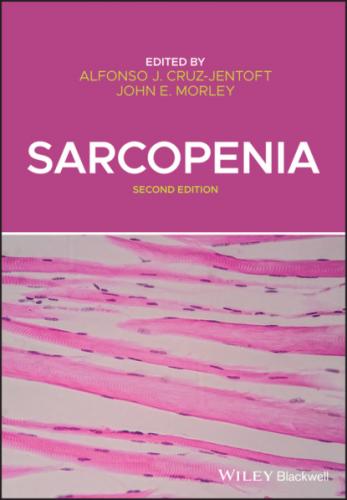24 24. Frontera WR, Hughes VA, Fielding RA, Fiatarone MA, Evans WJ, Roubenoff R, et al. Aging of skeletal muscle: a 12‐yr longitudinal study. J Appl Physiol [Internet]. 2000 Apr [cited 2018 Jul 16]; 88(4):1321–6. Available from: http://www.physiology.org/doi/10.1152/jappl.2000.88.4.1321
25 25. Evans WJ, Lexell J. Human aging, muscle mass, and fiber type composition. J Gerontol Ser A Biol Sci Med Sci [Internet]. 1995 Nov 1 [cited 2018 Jul 17]; 50A(Special):11–6. Available from: https://academic.oup.com/biomedgerontology/article‐lookup/doi/10.1093/gerona/50A.Special_Issue.11
26 26. McLeod M, Breen L, Hamilton DL, Philp A. Live strong and prosper: the importance of skeletal muscle strength for healthy ageing. Biogerontology 2016; 17(3):497–510.
27 27. Nilwik R, Snijders T, Leenders M, Groen BBL, van Kranenburg J, Verdijk LB, et al. The decline in skeletal muscle mass with aging is mainly attributed to a reduction in type II muscle fiber size. Exp Gerontol [Internet]. 2013 May 1 [cited 2018 Jul 17]; 48(5):492–8. Available from: https://www.sciencedirect.com/science/article/pii/S0531556513000430
28 28. Connelly DM, Rice CL, Roos MR, Vandervoort AA. Motor unit firing rates and contractile properties in tibialis anterior of young and old men. J Appl Physiol [Internet]. 1999 Aug [cited 2018 Nov 26]; 87(2):843–52. Available from: http://www.physiology.org/doi/10.1152/jappl.1999.87.2.843
29 29. Dalton BH, Jakobi JM, Allman BL, Rice CL. Differential age‐related changes in motor unit properties between elbow flexors and extensors. Acta Physiol [Internet]. 2010 Apr 1 [cited 2018 Nov 26]; 200(1):45–55. Available from: http://doi.wiley.com/10.1111/j.1748‐1716.2010.02100.x
30 30. Kamen G, Knight CA. Training‐related adaptations in motor unit discharge rate in young and older adults. J Gerontol Ser A Biol Sci Med Sci [Internet]. 2004 Dec 1 [cited 2019 Jan 29]; 59(12):1334–8. Available from: https://academic.oup.com/biomedgerontology/article‐lookup/doi/10.1093/gerona/59.12.1334
31 31. Christie A, Kamen G. Short‐term training adaptations in maximal motor unit firing rates and after hyperpolarization duration. Muscle Nerve [Internet]. 2009 May 1 [cited 2019 Jan 29]; 41(5):651–60. Available from: http://doi.wiley.com/10.1002/mus.21539
32 32. Kirk EA, Gilmore KJ, Rice CL. Neuromuscular changes of the aged human hamstrings. J Neurophysiol [Internet]. 2018 Aug [cited 2018 Nov 26]; 120(2):480–8. Available from: https://www.physiology.org/doi/10.1152/jn.00794.2017
33 33. Piasecki J, Inns TB, Bass JJ, Scott R, Stashuk DW, Phillips BE, et al. Influence of sex on the age‐related adaptations of neuromuscular function and motor unit properties in elite masters athletes. J Physiol 2020; doi:https://doi.org/10.1113/jp280679.
34 34. Hortobagyi T, Mizelle C, Beam S, DeVita P. Old adults perform activities of daily living near their maximal capabilities. J Gerontol Ser A Biol Sci Med Sci [Internet]. 2003 May 1 [cited 2018 Nov 26]; 58(5):M453–60. Available from: https://academic.oup.com/biomedgerontology/article‐lookup/doi/10.1093/gerona/58.5.M453
35 35. Medler S. Mixing it up: the biological significance of hybrid skeletal muscle fibers. J Exper Biol 2019; 222(23):jeb200832.
36 36. Kanda K, Hashizume K. Effects of long‐term physical exercise on age‐related changes of spinal motoneurons and peripheral nerves in rats. Neurosci Res [Internet]. 1998 May [cited 2019 Dec 11]; 31(1):69–75. Available from: http://www.ncbi.nlm.nih.gov/pubmed/9704980
37 37. Kryściak K, Majerczak J, Kryściak J, Łochyński D, Kaczmarek D, Drzymała‐Celichowska H, et al. Adaptation of motor unit contractile properties in rat medial gastrocnemius to treadmill endurance training: relationship to muscle mitochondrial biogenesis. PLoS One [Internet]. 2018 Apr 19 [cited 2019 Dec 11]; 13(4):e0195704. Available from: https://dx.plos.org/10.1371/journal.pone.0195704
38 38. Giorgetti E, Panesar M, Zhang Y, Joller S, Ronco M, Obrecht M, et al. Modulation of microglia by voluntary exercise or CSF1R inhibition prevents age‐related loss of functional motor units. Cell Rep 2019; 29(6):1539–1554.
39 39. Tayrose GA, Beutel BG, Cardone DA, Sherman OH. The masters athlete: a review of current exercise and treatment recommendations. Sports Health 2015 May 23; 7(3):270–6.
40 40. Power GA, Dalton BH, Behm DG, Vandervoort AA, Doherty TJ, Rice CL. Motor unit number estimates in masters runners: use it or lose it? Med Sci Sports Exerc 2010 Sep; 42(9):1644–50.
41 41. Sonjak V, Jacob K, Morais JA, Rivera‐Zengotita M, Spendiff S, Spake C, et al. Fidelity of muscle fibre reinnervation modulates aging muscle impact in elderly women. J Physiol 2019; 597(19):5009–5023.
42 42. Clark, B C, Taylor JL. Age‐related changes in motor cortical properties and voluntary activation of skeletal muscle. Curr Aging Sci 2012; 4(3):192–199.
43 43. Mckendry J, Breen L, Shad BJ, Greig CA. Muscle morphology and performance in master athletes: a systematic review and meta‐analyses. Ageing Res Rev 2018; 45:62–82.
CHAPTER 5 Nutrition, Protein Turnover and Muscle Mass
Stéphane Walrand1, Christelle Guillet2 and Yves Boirie1
1 Université Clermont Auvergne, CHU Clermont-Ferrand, INRAE, UNH, F-63000 Clermont—Ferrand, France
2 Université Clermont Auvergne, INRAE, UNH, F-63000 Clermont—Ferrand, France
INTRODUCTION
Muscle erosion, which begins after the age of 50 years, is one of the most important factors of disability in older people, but it may also occur early in life in case of chronic disease [1]. The cumulative decline in muscle mass reaches 40% from 20 to 80 years. The magnitude of this phenomenon as a public health problem is now well established as there has been a lot of epidemiological studies and meta‐analysis focusing on the decrements of strength and muscle mass with advancing age. So, sarcopenia has been recognized as a specific disease with an International Classification of Diseases (ICD) code (M62.84) [2]. The reduction in muscle mass and strength provokes an impaired mobility and increased risk for falls and fall‐related fractures. In addition, muscle loss is associated with a decrease in overall physical activity levels with subsequent metabolic alterations such as obesity, insulin resistance, and a reduction in bone density in older persons. Sedentary individuals, subjects with poor protein intakes, low vitamin D and low testosterone levels, and those suffering from debilitating or inflammatory diseases are at greater risks of sarcopenia. As older person population increases around the world, the involuntary loss of muscle mass with aging
